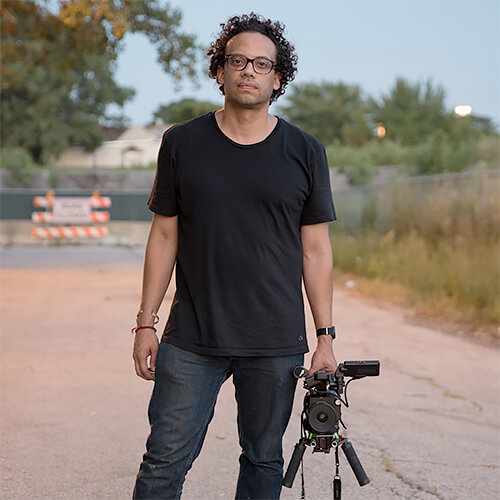Carlos Javier is a director, cinematographer and documentary photographer who focuses on urban life, gun violence, racism, poverty and marginalized communities. In 2016, Carlos received a Guggenheim Fellowship for film/video. His work has been exhibited nationally and internationally in a variety of venues including the Schomburg Center for Research in Black Culture; the Worcester Art Museum in Massachusetts; the International Museum of Photography and Film in Rochester, NY; the Museum of Contemporary Photography in Chicago; the Detroit Institute of Arts; and the Library of Congress.
In addition, his photos were used to illustrate Ta-Nehisi Coates' The Case for Reparations (2014) article, which was the best selling issue in the history of the Atlantic Magazine. His photos have also been published in The New Yorker, Mother Jones, among many others. He is represented by the Karen Jenkins-Johnson Gallery in San Francisco.
His film, We All We Got, uses images and sounds to convey a community's deep sense of loss and resilience in the face of gun violence. We All We Got has been screened at the Tribeca Film Festival, Los Angeles International Film Festival, St. Louis International Film Festival, CURRENTS Santa Fe International New Media Festival, and the Athens
International Film + Video Festival.
Carlos' current project is series of short films chronicling the contemporary stories of Black Americans who came to the North during the Great Migration. Beginning with his mother-in-law's story, Carlos is exploring the legacy of the Great Migration a century after it began. For Carlos, who moved back and forth between Puerto Rico and the U.S. mainland as a child, the story of a displaced people in search of stability and economic opportunity resonates with his own.
Carlos' work has been supported by many organizations including: the University of Chicago Black Metropolis Research Consortium Short-term Fellowship (2015); the Economic Hardship Reporting Project (2015); the Pulitzer Center on Crisis Reporting (2013); the California Endowment National Health Journalism Fellowship (2012); the Richard H. Driehaus Foundation (2011); Open Society Institute Audience Engagement Grant (2011); and the Illinois Arts Council Artist Fellowship Award (2011).
In addition to his photography and film, Carlos Javier has taught at Northwestern University and the University of California, Berkeley. He lives in Chicago and Oakland with his wife and frequent collaborator, Tina K. Sacks, a professor of social welfare at
the University of California, Berkeley.
Selected Books on

